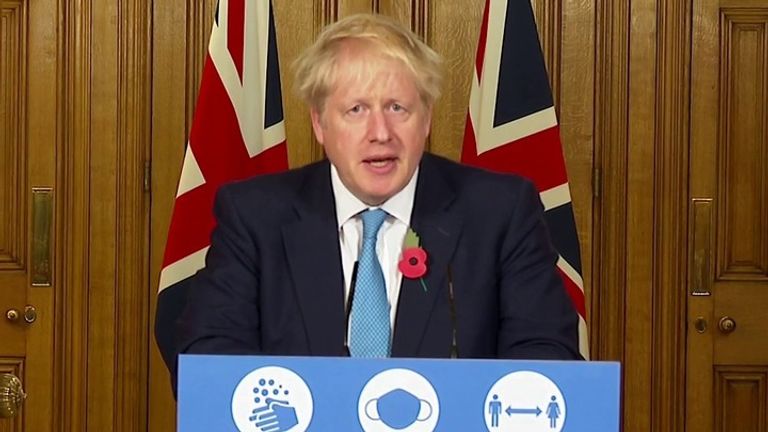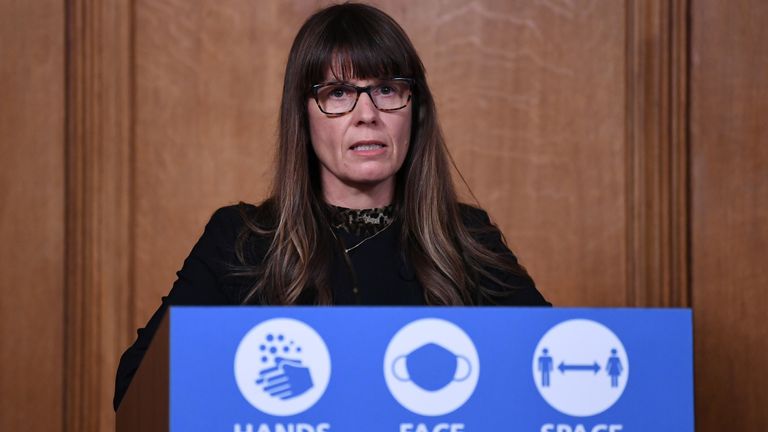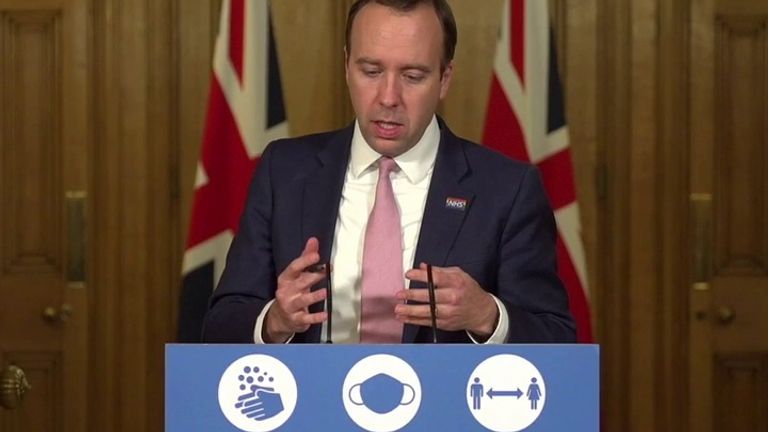COVID-19: England may face almost month-long lockdown in exchange for Christmas five-day rules relief
England could face nearly a month-long extra lockdown in exchange for five days’ release from restrictions over Christmas, it has been suggested.
Dr Susan Hopkins, medical director of Test and Trace, indicated that for every day the rules are relaxed over the festive period, two more under harsher measures may be needed to crack down again on coronavirus.
Public Health England (PHE) later intervened to say Dr Hopkins ‘misspoke’.
A spokesman said the government’s advisory body, SAGE, actually indicated for every day of relaxation five days of tighter restrictions would potentially be needed.
Live updates on coronavirus from UK and around world
The Sun reported that ministers are considering letting families choose a small number of households they can socialise indoors with for five days, starting on Christmas Eve.
If that happens, then the country would potentially have to endure 25 more days of restrictions – plus the cost of spreading COVID-19 to family members.
At a Downing Street briefing on Wednesday, Dr Hopkins revealed she hoped the government will “allow some mixing” of households over Christmas.
But she suggested this would come at the cost of tougher rules before and after 25 December, initially claiming that every day of relaxed measures would need to be counterbalanced with two days of restrictions.
Within a few hours, PHE said she misspoke and had actually meant to say that “for every one day of relaxation, *five* days of tighter restrictions would potentially be needed”, according to modelling from the government’s science advisers known as SAGE.
Prime Minister Boris Johnson’s spokesman said he has a “clear intent to allow families to spend Christmas together”, but stressed it will “not be a normal” one.
The plan being considered would mean no household mixing when national lockdown ends in England on 2 December, with all parts of the country under at least Tier 2 restrictions, according to The Daily Telegraph.
When asked about the plans by Kay Burley on Wednesday, Business Secretary Alok Sharma said it was too early to say exactly what the rules will be.
“Christmas is of course going to happen come what may. I would love to have members of my family round, but we just have to wait and see where we’re at,” he said.
The PM has repeatedly stated his intention to return England to a tier system when lockdown ends in two weeks, but Dr Hopkins said ministers are now working on “new tiers” after low level of restrictions proved ineffective.
An announcement is expected next week.
People in Wales have been strongly advised not to mix with people they don’t live with indoors after its “circuit break” lockdown came to an end, with the same expected in Northern Ireland once theirs finishes this week.
In Scotland, First Minister Nicola Sturgeon announced on Tuesday that 11 local authority areas will be put under the country’s toughest Level 4 measures from Friday until 11 December.
Her deputy John Swinney told Kay Burley on Wednesday the current rules will “enable us all to be able to proceed to enjoy and appreciate the connections we all want to have with family around Christmas time”.
Reports that the first round of Pfizer/BioNTech vaccines could be rolled out by mid-December has sparked hopes of a more “normal” Christmas, but a Downing Street spokesman told Sky News: “No decision has been made.”
Housing Secretary Robert Jenrick confirmed on Tuesday that parliament will vote on what system is imposed in England beyond 2 December.
Analysis: Christmas freedom creates one hell of a lockdown hangover
By Rowland Manthorpe, technology correspondent
Boris Johnson famously likes to have his cake and eat it.
But a Christmas holiday during a pandemic is a situation where there are only hard choices with little room for flexibility.
On the one hand, if people move around and spend long periods of time with each other indoors, then cases will rise.
If that happens from a point where prevalence is already high, as it is now, then the effects on health and life could be very serious.
On the other hand, families around the country are determined to see each other over the holiday, and retailers who take most of their profits over the festive season are desperate to open their doors to customers.
The prime minister and his advisors will have hoped that a November lockdown was going to drive the outbreak down enough to create some breathing room during December.
While there are some signs that cases and hospital admissions are beginning to level off, they are still at a high level. There is little sign that safety is coming soon.
It is always possible to look back at decisions that could have been made differently.
What would have happened if the last big movement of people, students going to university, had been kept online? What would this choice be like if the government had introduced a circuit breaker lockdown over the October half term?
But looking forward, it is hard to see an obvious resolution.
Whatever the final decision is, it is clear that the way it is communicated matters.
Behavioural scientists have repeatedly warned that leaks and briefings about future plans are getting in the way of compliance. A decisive, clear intervention could make the best of this situation.
If not then it is quite possible that we could find ourselves back in lockdown as early as January.
Susan Hopkins’ comments today suggest that a five-day Christmas would turn into a 25-day January lockdown.
That, by any standards, is one hell of a hangover.
Source: Read Full Article





